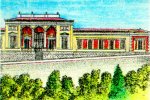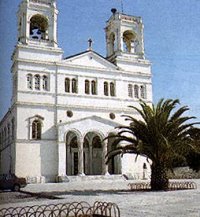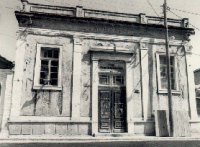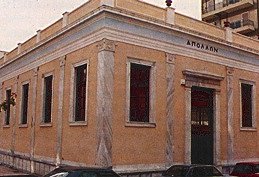Pyrgos
 Pyrgos
is the capital of the Prefecture of Ilia and its biggest city. It is a
relatively new city, since its foundation took place during the occupation
of Greece by the Turks, build on seven small hills. It is 4 kilometres
far from the sea, 19 kilometres from Ancient Olympia and 315
kilometres from the Greek capital, Athens. Its main landmarks are the two
exquisite neoclassical buildings designed by Schiller, the Municipal
Market and the Apollo Municipal Theatre plus the
central square with the Eparcheion. Today it is inhabited
by about 35.000 people.
Pyrgos
is the capital of the Prefecture of Ilia and its biggest city. It is a
relatively new city, since its foundation took place during the occupation
of Greece by the Turks, build on seven small hills. It is 4 kilometres
far from the sea, 19 kilometres from Ancient Olympia and 315
kilometres from the Greek capital, Athens. Its main landmarks are the two
exquisite neoclassical buildings designed by Schiller, the Municipal
Market and the Apollo Municipal Theatre plus the
central square with the Eparcheion. Today it is inhabited
by about 35.000 people.
At the place where the city is
build today, archaeologists locate the Ancient city of Dyspontion
while at the city's suburban the Ancient city of Letrina.
From this ancient city came the official name of Pyrgos, as 'Letrina',
until the 1980's, when the official name changed to Pyrgos. The city owes
its name to a tower (in Greek 'Pyrgos'),
located at the Eparcheion ,
build by Ioannis Tsernotas the years 1512-1520 A.D. This tower existed
in its place until the June of 1825, when the citizens, after the Sunday
church pulled it down, blinded by civil fights.
,
build by Ioannis Tsernotas the years 1512-1520 A.D. This tower existed
in its place until the June of 1825, when the citizens, after the Sunday
church pulled it down, blinded by civil fights.
Legend says that in 1512, Ioannis
Tsernotas found in a well, near Neochori of Pyrgos, many ancient
coins. He travelled to Constantinople where he offered them to the Sultan
Selim, taking the privilege to be named Bei and the ownership of a great
area of land around Pyrgos. Tsernota's well existed until the middle 70's
when it was covered 'due to progress'.
The city's growth was very fast.
It is mentioned for the first time, with the name of Pyrgos, in 1687, when
for an interval of 25 years Venice dominated western Peloponnese. Its population,
at that time, was about 5.000, consisted all by Greeks. Pyrgos took an
important role at the Greek revolution of 1821. The revolution at the city
started the 29th of March 1821, by Charalampos Villaetis
and many residents offered themselves to the cause.
 After
the liberation of Greece, Pyrgos became one of the important cities of
Greece. The rate of growth was very fast and in 1870 the population was
9.000 (at a time when Athens had 45.000 inhabitants).
After
the liberation of Greece, Pyrgos became one of the important cities of
Greece. The rate of growth was very fast and in 1870 the population was
9.000 (at a time when Athens had 45.000 inhabitants). An important role to its growth, played the production and commerce of
raisin. The railroad that connected Pyrgos with the city's harbour, Katakolo,
(with a length of 13 kilometres) is the second railroad constructed in
Greece and the first outside Athens. At that time, were constructed many
neoclassical buildings and houses in the city, like the Municipal Theater
and the Municipal Market. Unfortunately, today, many of the old neoclassical
houses have been replaced by apartment buildings.
An important role to its growth, played the production and commerce of
raisin. The railroad that connected Pyrgos with the city's harbour, Katakolo,
(with a length of 13 kilometres) is the second railroad constructed in
Greece and the first outside Athens. At that time, were constructed many
neoclassical buildings and houses in the city, like the Municipal Theater
and the Municipal Market. Unfortunately, today, many of the old neoclassical
houses have been replaced by apartment buildings.
The city's growth stopped for many
years, as the commerce of raisin became non profitable. The last years
there is a considerable rate of growth due to the improvement of the agricultural
production, while, after the earthquakes that destroyed many buildings
of the city at 1993, there is great building activity.
[back to Region page]
 Pyrgos
is the capital of the Prefecture of Ilia and its biggest city. It is a
relatively new city, since its foundation took place during the occupation
of Greece by the Turks, build on seven small hills. It is 4 kilometres
far from the sea, 19 kilometres from Ancient Olympia and 315
kilometres from the Greek capital, Athens. Its main landmarks are the two
exquisite neoclassical buildings designed by Schiller, the Municipal
Market and the Apollo Municipal Theatre plus the
central square with the Eparcheion. Today it is inhabited
by about 35.000 people.
Pyrgos
is the capital of the Prefecture of Ilia and its biggest city. It is a
relatively new city, since its foundation took place during the occupation
of Greece by the Turks, build on seven small hills. It is 4 kilometres
far from the sea, 19 kilometres from Ancient Olympia and 315
kilometres from the Greek capital, Athens. Its main landmarks are the two
exquisite neoclassical buildings designed by Schiller, the Municipal
Market and the Apollo Municipal Theatre plus the
central square with the Eparcheion. Today it is inhabited
by about 35.000 people.
 ,
build by Ioannis Tsernotas the years 1512-1520 A.D. This tower existed
in its place until the June of 1825, when the citizens, after the Sunday
church pulled it down, blinded by civil fights.
,
build by Ioannis Tsernotas the years 1512-1520 A.D. This tower existed
in its place until the June of 1825, when the citizens, after the Sunday
church pulled it down, blinded by civil fights.
 After
the liberation of Greece, Pyrgos became one of the important cities of
Greece. The rate of growth was very fast and in 1870 the population was
9.000 (at a time when Athens had 45.000 inhabitants).
After
the liberation of Greece, Pyrgos became one of the important cities of
Greece. The rate of growth was very fast and in 1870 the population was
9.000 (at a time when Athens had 45.000 inhabitants). An important role to its growth, played the production and commerce of
raisin. The railroad that connected Pyrgos with the city's harbour, Katakolo,
(with a length of 13 kilometres) is the second railroad constructed in
Greece and the first outside Athens. At that time, were constructed many
neoclassical buildings and houses in the city, like the Municipal Theater
and the Municipal Market. Unfortunately, today, many of the old neoclassical
houses have been replaced by apartment buildings.
An important role to its growth, played the production and commerce of
raisin. The railroad that connected Pyrgos with the city's harbour, Katakolo,
(with a length of 13 kilometres) is the second railroad constructed in
Greece and the first outside Athens. At that time, were constructed many
neoclassical buildings and houses in the city, like the Municipal Theater
and the Municipal Market. Unfortunately, today, many of the old neoclassical
houses have been replaced by apartment buildings.